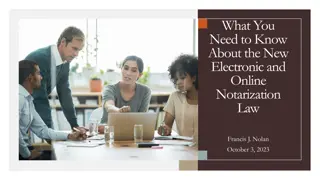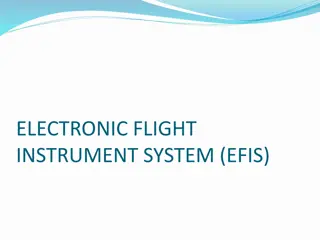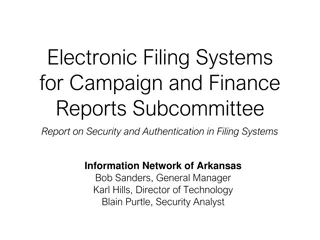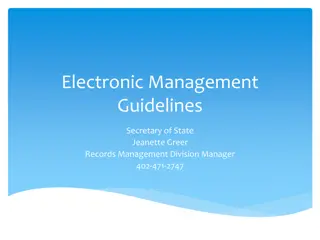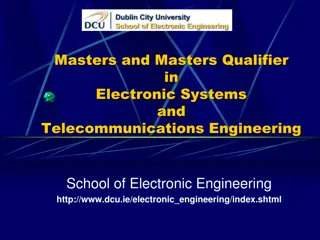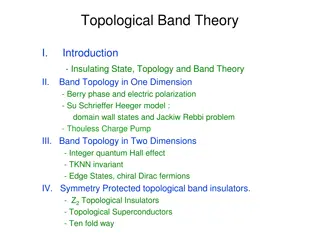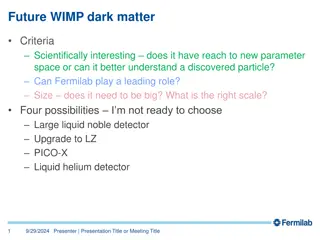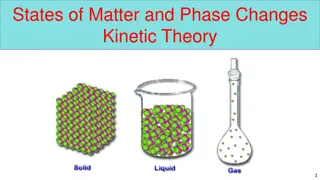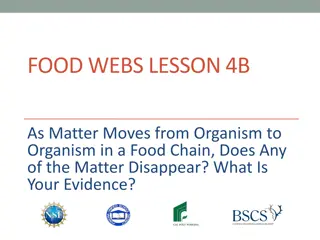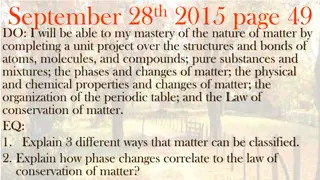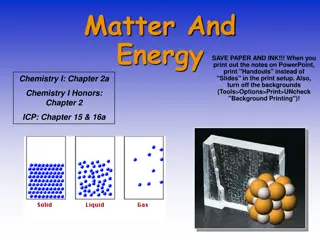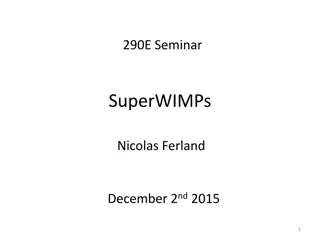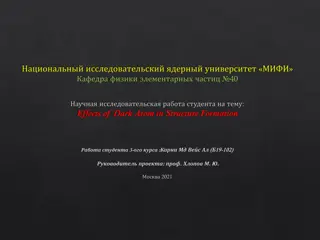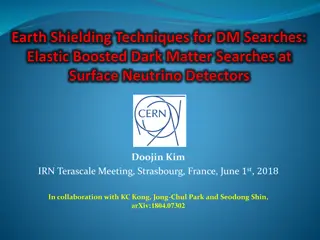ELECTRONIC VOTING PC HOME AFFAIRS March 2023
Delve into the realm of electronic voting systems with a comprehensive examination of defining e-voting, its types, global status, and valuable lessons learned from past experiences. Explore the controlled and uncontrolled environments of e-voting, including EVMs, DREs, and emerging technologies lik
0 views • 21 slides
IEEE Council on Electronic Design Automation (CEDA) - Empowering Innovation in Electronic Circuits and Systems
IEEE CEDA, established in 2005, focuses on the theory, implementation, and utilization of EDA/CAD tools for designing integrated electronic circuits and systems. The organization aims to lead in providing technical information and community services related to the design and automation of electronic
3 views • 19 slides
Introduction to Chemistry: Matter, Energy, and Measurement
Chemistry is the study of matter, its properties, and the changes it undergoes. This content covers the basics of chemistry, including the classification of matter into pure substances and mixtures, different states of matter, and the building blocks of matter such as atoms and molecules. Sample exe
5 views • 51 slides
Understanding Properties and States of Matter in Physical Science
Matter is made up of elements that cannot be broken down further. Different mixtures have distinct properties, such as solutions, colloids, and suspensions. Physical properties like viscosity and density can be observed without changing the material's composition. Chemical properties, like flammabil
2 views • 15 slides
Understanding the New Electronic and Online Notarization Law
The article explores the evolution of notarial acts, including Remote Online Notarization (RON), Electronic Notarization, and considerations for Unauthorized Practice of Law (UPL). It discusses the challenges and opportunities presented by electronic and remote notarization methods, as well as insig
1 views • 24 slides
LAUSD Electronic Payment Card Guidance and Procedures
LAUSD Office of Accounting and Disbursement provides detailed guidance and procedures for electronic payment card services, including establishing services, acceptance procedures, terminal operation, reports, and more. Merchants within LAUSD are guided on how to handle electronic transactions secure
1 views • 30 slides
Understanding Electronic Flight Instrument System (EFIS)
An Electronic Flight Instrument System (EFIS) replaces traditional flight deck instruments with electronic displays like the Primary Flight Display (PFD) and Multi-Function Display (MFD). EFIS enhances situational awareness for pilots by consolidating critical flight data in a single, easy-to-read i
0 views • 12 slides
Security and Authentication in Electronic Filing Systems: Arkansas Subcommittee Report
Explore the subcommittee report on security and authentication in electronic filing systems for campaign and finance reports in Arkansas. Learn about user authentication, risks, mitigation strategies, and approaches used in other states. Discover the filing processes in both paper and electronic for
0 views • 24 slides
Understanding Matter in Our Surroundings
Matter in Our Surroundings discusses the classification of matter, physical nature of matter, and the properties of matter particles such as size, space between them, and continuous movement. It explains how matter is made up of particles and how they interact with each other through various activit
0 views • 27 slides
Unveiling Dark Matter Mysteries Through Dark Photons
Delve into the exploration of dark matter through the lens of dark photons in the galactic center and detectors. Uncover the enigmatic nature of dark matter, its interactions, existing constraints, and our model with fermionic dark matter and a dark photon mediator. Discover strategies to evade cons
0 views • 18 slides
Exploring Neutralino Dark Matter Mass Limits
Hajime Fukuda, along with researchers Shirai and Luo, conducted a study on the maximum mass of Neutralino dark matter particles. They investigated coannihilation effects and how colored sparticles can enhance LSP annihilation. The study delves into the implications for TeV-scale supersymmetry models
0 views • 39 slides
Exploring Quarkyonic Matter and Chiral Pairing Phenomena
Investigate the characteristics of quarkyonic matter and chiral pairing phenomena in the context of dense QCD at T=0. Delve into the confinement aspects, the properties of quarkyonic matter near T=0, and the candidates for chiral symmetry breaking. Consider the implications of chiral pairing phenome
0 views • 42 slides
Best Practices for Electronic Records Management
Electronic records management guidelines outlined by Secretary of State Jeanette Greer emphasize the importance of retaining and managing electronic records effectively. Understanding the definition of records, handling cluttered records retention, and managing electronic records properly are crucia
1 views • 19 slides
Exploring Dark Matter in Neutron Stars
Investigate the interaction of dark matter within neutron stars, comprising approximately 25% of the universe's total matter. The nature of dark matter assumptions, its distribution within neutron stars based on fermionic or bosonic properties, and the implications for self-interacting fermionic and
0 views • 22 slides
Managing Draft & Proposed Clean Air Act Permits Using Electronic Permit System
Explore how the Electronic Permit System (EPS) streamlines the management of Clean Air Act permits, reducing paper usage, easing document handling, and lowering costs. Learn about the various requirements, tools, and practices involved in the permit process as outlined by the EPA Region 9 Air Divisi
0 views • 18 slides
Understanding Matter and its Classification in Chemistry
Matter is defined as anything that occupies space and has mass. It can be classified into solids, liquids, and gases, as well as pure substances and mixtures based on their composition. This overview covers the states of matter, Aristotle's four elements theory, and the classification of matter into
0 views • 13 slides
Electronic Systems and Telecommunications Engineering Masters Programme at School of Electronic Engineering
This program offers Master's and Master Qualifier degrees in Electronic Systems and Telecommunications Engineering at the School of Electronic Engineering, with modules such as Image Processing & Analysis, Nanoelectronics & Photonics, Semiconductor Manufacturing, and Network Implementation. The prog
0 views • 25 slides
Searching for Dark Photon Dark Matter with Cosmic Ray Antideuterons
Exploring the use of cosmic ray antideuterons for dark matter detection is a promising avenue in astrophysics. Antideuteron searches offer a low-background environment, making them ideal for detecting certain types of dark matter particles. Unlike antiproton searches, which face significant backgrou
0 views • 30 slides
Understanding States of Matter and Kinetic Theory
Matter is anything that occupies space and has mass, existing in solid, liquid, gas, and plasma states. The states of matter depend on the arrangement and motion of atoms. Solids have fixed shapes, liquids take the shape of their container, and gases fill the volume of their container. The Kinetic T
0 views • 18 slides
Exploring the World of Matter and Elements
Matter is the physical "stuff" of the universe, encompassing elements that make up rocks, wood, air, metals, water, and living organisms. Chemical elements are the building blocks of matter, with essential elements like oxygen, carbon, hydrogen, and nitrogen constituting a significant part of living
0 views • 24 slides
Exploring Matter and Physical/Chemical Changes in Science Class
Delve into the world of matter and its transformations through engaging activities such as classifying elements, compounds, and mixtures using nuts, bolts, and washers. Understand the concepts of mass, space, and the different types of matter through hands-on learning experiences in this interactive
0 views • 31 slides
Understanding Gray Matter in the Brain: Structure, Function, and Importance
Gray matter in the brain plays a crucial role in information processing and cognitive functions. Composed of neuronal cell bodies and unmyelinated axons, gray matter is visibly pinkish-gray and is essential for various brain functions. It forms a synaptically dense area with fewer cell bodies compar
0 views • 7 slides
Dispersed Organic Matter in Sedimentary Rocks - Review Paper for Geological Application Studies in the 21st Century
The WG on Dispersed Organic Matter in Sedimentary Rocks is working on a review paper focusing on application studies of dispersed organic matter (DOM) within a geological context. The paper aims to provide an insightful overview titled "Applications of Dispersed Organic Matter Petrology in the 21st
0 views • 18 slides
Exploring Topological Band Theory and Quantum Phases in Electronic Matter
Delve into the fascinating realm of topological band theory, examining the insulating state, band topology in different dimensions, symmetry-protected topological band insulators, and the interplay between symmetry and topology. Uncover the principles underlying matter symmetry, quantum phases, and
0 views • 29 slides
Understanding Matter: Solids, Liquids, Gases, and Fluids
Matter exists in various states - solid, liquid, gas, and fluid. Solids have atoms closely packed, liquids have more freedom but still cohesion, gases have atoms spread out, and fluids flow like liquids or gases. Mass density characterizes matter based on atom proximity. Gas pressure results from mo
0 views • 22 slides
Future Prospects in Dark Matter Research at Fermilab
Exploring new avenues in the realm of dark matter research, Fermilab stands at the forefront with potential upgrades to their detectors, such as the LZ and PICO-X. The presentation delves into the scientific criteria influencing the choice of detectors, the pursuit of understanding dark matter and d
0 views • 6 slides
Understanding Properties of Matter in the Matter and Change Unit
Exploring matter, mass, weight, volume, and states of matter in the context of physical properties and compositions of substances. Discover how substances differ, the importance of uniform composition in materials, and the distinction between substances and mixtures.
0 views • 23 slides
Understanding Matter: States, Properties, and Changes
Matter is anything with mass and volume, existing in solid, liquid, or gas states. The Kinetic Molecular Theory explains the behavior of particles in matter. Chemistry explores matter through chemical and physical changes. Different factors, like temperature, can change the state of matter. Physical
0 views • 6 slides
Understanding Matter: Properties and Changes
Matter is anything that has mass and volume. This includes the concepts of mass, volume, chemical changes, temperature effects, particle model, kinetic molecular theory, and describing matter based on physical properties. Learn about different states of matter, such as solids, liquids, and gases, an
0 views • 9 slides
Understanding Kinetic Theory of Matter and Phases
Explore the fundamental concepts of the Kinetic Theory of Matter, including the three pillars of kinetic energy and forces of attraction, which determine the states of matter like solid, liquid, gas. Learn about temperature, phase changes, and the phases of matter, emphasizing the role of kinetic en
0 views • 17 slides
Exploring Food Chains: Does Matter Disappear Along the Way?
In this lesson on food chains, students investigate whether matter disappears as it moves from one organism to another. Using a linking-cube simulation, they track food molecules mathematically to determine if any matter is lost in the process. The lesson involves hands-on activities and observation
0 views • 30 slides
Exploring the Nature of Matter: Unit Project Overview
Embark on a journey to understand the structures and bonds of matter through a comprehensive unit project. Delve into atoms, molecules, compounds, pure substances, mixtures, phases of matter, properties, periodic table, and conservation laws. Explore matter classification and phase changes' relation
0 views • 9 slides
Introduction to Chemistry and Matter
Understanding chemistry involves studying the properties of matter and its changes. Matter is anything that occupies space and has mass, composed of vibrating atoms. It includes examples like air, water, books, desks, and people, while non-examples are light, sound, thoughts, and emotions. Physical
0 views • 18 slides
Understanding Matter and Energy in Chemistry: A Comprehensive Overview
Exploring the intricate nature of matter, this collection delves into the fundamentals of chemistry, from the macroscopic to the particulate level. Covering topics such as the states of matter, kinetic nature, physical properties, and other states of matter like plasma and Bose-Einstein condensate,
0 views • 18 slides
Revolutionizing Bail Bonds: The Shift to Electronic Processes
Explore the future of bail bonds with the advent of electronic systems. Discover how electronic bonds are created, issued, and audited, benefitting both sheriffs and court clerks. Learn how to submit electronic bonds hassle-free, without additional software requirements.
1 views • 7 slides
Exploring Matter and its Properties
Matter is the fundamental component of everything around us, existing in various forms such as solids, liquids, and gases. This article delves into the states of matter, chemical changes, physical changes, and the kinetic molecular theory, shedding light on the basic building blocks of life and the
0 views • 8 slides
Exploring the Mysteries of Dark Matter and SuperWIMPs
Dark matter, detected only gravitationally, poses enigmatic characteristics and poses challenges in direct detection. Scientists search for interactions with particles, explore hypothetical undetectable forms, and consider production mechanisms. SuperWIMPs like NLSP and NLK decay into Dark Matter, k
0 views • 16 slides
Understanding Matter and Its Changes
Matter is anything that has mass and takes up space. By identifying physical properties and understanding physical changes, we can explore the different states of matter - solid, liquid, gas, and plasma. Measuring properties like length, mass, volume, and density helps us characterize and differenti
0 views • 24 slides
Exploring Dark Atom Effects on Structure Formation in the Universe
Overwhelming evidence points towards the existence of dark matter in the universe, with various theoretical models such as OHe atoms and Glashow's EIMP model proposed to explain its nature. Dark OHe atoms, consisting of 2 charged particles bound with primordial He nuclei, offer a unique perspective
1 views • 8 slides
Dark Matter Search at Terascale Meeting in Strasbourg
Doojin Kim presents research on non-relativistic dark matter search, focusing on weakly interacting massive particles (WIMPs) and generic boosted dark matter (BDM) signatures at the Terascale Meeting in Strasbourg. The study explores various scenarios and production models for detecting elusive dark
0 views • 24 slides




